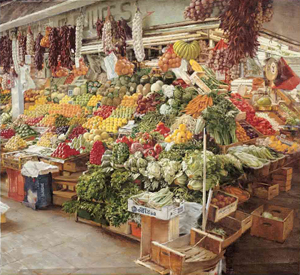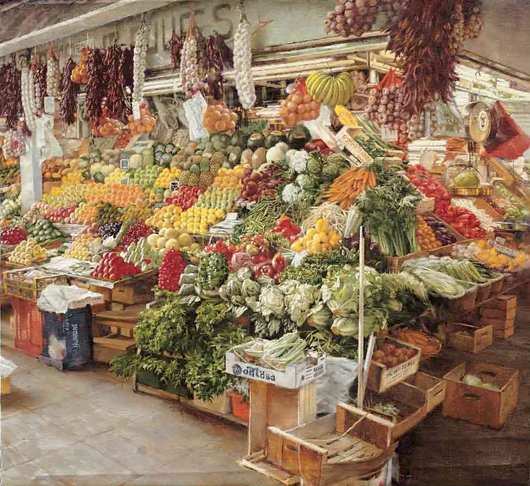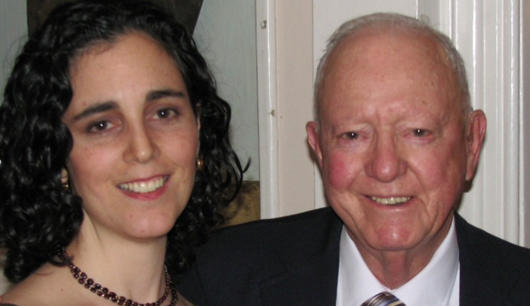
NEW YORK – Seven prominent professionals have been chosen as judges to select the first two grants winners for the Clark Hulings Fund for Burgeoning Visual Artists. They include Meredith Bergmann, Peter Falk, Thomas R. Kellaway, Philip Koch, Dan Ostermiller, Jennie Ottinger, and Bart Walter.
“I am honored to have this distinguished group of art professionals on the Fund’s inaugural judging panel,” said Elizabeth Hulings, the late Clark Hulings’ daughter. “Because they are from different parts of the country, work in a variety of media to produce different kinds of art, and themselves are at different stages of their careers, I think each of them brings a unique perspective to the judging process.”
From September 1 through 30, 2013, the fund, which was established to aid emerging artists from all genres, will accept applications from working painters and sculptors to pursue the same course of success that Clark Hulings enjoyed. According to Ms. Huligs, the grant winners, who will each receive up to $5,000, will be announced in November 2013. To apply visit: www.clarkhulings.com/the-fund.com.
Meredith Bergmann, a sculptor for over 35 years, has been making work that deals with complex themes in an accessible, beautiful and stimulating way. She works both on public monuments and on a private scale. Her largest public commission, unveiled in 2003, was for the Boston Women’s Memorial on Commonwealth Avenue in Boston’s Back Bay. She recently unveiled a September 11th memorial for the Cathedral of St. John the Divine in New York City and is currently sculpting the FDR Hope Memorial for Roosevelt Island, NY.
Best known as a pioneer in the publishing of art reference books, Peter Falk has become best known for the award-winning three-volume biographical dictionary, Who Was Who in American Art. In the 1990s he published the leading art auction price records and was the founding Editor-in-Chief of ArtNet. Since 2000 he has been Editor of Artprice. He is also well known as an art appraiser, consultant, and manager of artist estate collections. As an art historian he has written dozens of critical monographs on artists and is founder of RediscoveredMasters.com.
Thomas R. Kellaway is the founding editor and publisher of American Art Review, the premier publication for articles on American art and artists from the colonial period to 1970, with a primary focus on exhibitions of representational art in regional museums. With a broad interest in the arts, Kellaway served in the 1980s as a Trustee of the Eugene O’Neill Memorial Theatre and President of the Regional Center for the Performing Arts (both in New London, Connecticut), and as Secretary of the Connecticut Association of Historic Theatres. More recently, he has been a member of the Governor’s Council on the Arts for the State of Kansas, and Chairman of the Arts Commission for the city of Leawood, Kansas.
The former abstract artist, Phillip Koch, was inspired in his early 20s to turn to painting realist landscapes after viewing the work of the famous American artist Edward Hopper. Since 1983 Koch has enjoyed twelve residencies in Hopper’s former studio on Cape Cod. Koch has had his work spotlighted in 14 solo exhibitions in American art museums including the Butler Institute of American Art, the Saginaw Art Museum, and the Swope Art Museum. Koch’s paintings are in the Permanent Collections of twelve American art museums. Koch is a Professor at the Maryland Institute College of Art in Baltimore.
Dan Ostermiller is a sculptor of animals and has enlarged the scope of his knowledge of wildlife with expeditions to Alaska, Africa and all corners of the West. In 2003, he became president of the National Sculpture Society. His sculpture has won numerous awards and honors and has been included in exhibitions and one-person shows around the country. Included in the noteworthy list is the annual Society of Animal Artists exhibition; the annual National Sculpture Society exhibition; the Eiteljorg Invitational at the Eiteljorg Museum of American Indian and Western Art in Indianapolis, Indiana; and the Fleischer Museum’s 1994 retrospective exhibition in Scottsdale, Arizona.
Jennie Ottinger earned her BFA from California College of the Arts and her MFA from Mills College. Her paintings are exhibited extensively in the San Francisco Bay Area as well as in New York, Miami, Dallas, Los Angeles and London. She was awarded a fellowship at the Kala Art Institute, the Sara Lewis Scholarship Award from Mills College and was a 2010 finalist for the SECA (Society for the Encouragement of Contemporary Art) award.
A full-time sculptor for three decades, Bart Walter ‘s work can be found in notable public and private collections worldwide: be it in the museum, gallery, or zoo, his art is exhibited in myriad locations. Walter travels extensively to pursue honest interpretations of his subjects, from lions and chimpanzees to more local North American wildlife. Sculpting and drawing directly from life allows him to infuse vitality and spontaneity into his work. His bronze sculptures are sought- after by international collectors and cultural institutions.
About Clark Hulings:
The late Clark Hulings’ ascendency in the art realm began in 1945 with a one-man show in Santa Fe, N.M., the first of two-dozen gallery presentations he would have over the course of a peripatetic 65-year career. The capstone show took place at New York City’s esteemed Forbes Gallery in 2011, just seven weeks after his death. Writing about this solo exhibition, “Clark Hulings: An American Master,” in a lengthy article about it in the March/April 2011 Fine Art Connoisseur, Peter Trippi called Hulings’ vividly realistic tableaux of village and farm life in Europe, Mexico and the United States “superb.”
Even though Hulings’ representational works stand in stark contradistinction to the Expressionistic, Pop and Minimalist creations of his peers, Trippi noted that he relished “enormous success among private collectors and commercial galleries, yet never became familiar to [the] mainstream,” a circumstance that produced no resentment on Hulings’ part. “I enjoyed what I was doing so much that there was no point in trying to be somebody else,” he said genially. “I decided to be the best I could be in painting conventional subjects in a traditional style.”
Hulings took a keen interest in colleagues who appreciated his self-assured approach, sharing his expertise with them at institutions like the New York City’s venerable Art Students League. Following Hulings’ death, at age 88, his wife Mary and daughter Elizabeth considered ways for them to carry on his collaborative spirit, leading them to establish The Clark Hulings Fund for Burgeoning Visual Artists.
All contributions to the Clark Hulings Fund, a 501(c)3, are tax-deductible. For more information, visit www.clarkhulings.com.
# # #
ADDITIONAL IMAGES OF NOTE




